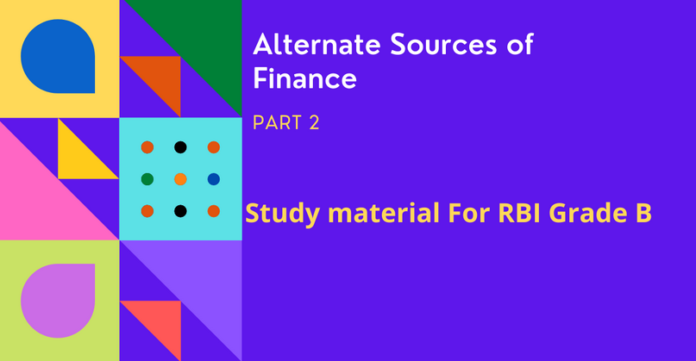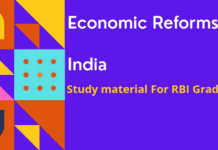Alternate sources of Finance is one of the topic that is confusing as there is a limited clarity about it. We are releasing a material on this based on a best guess method. This is part of RBI Grade B -Phase 2- Finance Syllabus.
Alternate Sources of Finance – Part 2
Public Equity
In this process the equity (Share in business) is offered to general public through Initial Public Offering (IPO) and FPO. It’s suitable for well established companies.
Private costs and benefits
Private Costs: Private costs for a producer of a good, service, or activity include the costs the firm pays to purchase capital equipment, hire labor, and buy materials or other inputs. Private costs are paid by the firm or consumer and must be included in production and consumption decisions. In a competitive market, considering only the private costs will lead to a socially efficient rate of output only if there are no external costs.
External costs, on the other hand, are not reflected on firms’ income statements or in consumers’ decisions. However, external costs remain costs to society, regardless of who pays for them. Consider a firm that attempts to save money by not installing water pollution control equipment. Because of the firm’s actions, cities located down river will have to pay to clean the water before it is fit for drinking, the public may find that recreational use of the river is restricted, and the fishing industry may be harmed. When external costs like these exist, they must be added to private costs to determine social costs and to ensure that a socially efficient rate of output is generated.
Social costs include both the private costs and any other external costs to society arising from the production or consumption of a good or service.
Private Costs + External Costs = Social Costs
Social benefits are the total benefits to the society, arising from an economic activity. They include both private and external benefits. Again, where social benefits are greater than private benefits, external benefits exist
Social benefit = Private benefit + external benefit
PPP
What is Public Private Partnership?
A public-private partnership (PPP) involves the private sector in aspects of the provision of infrastructure assets or of new or existing infrastructure services that have traditionally been provided by the government. While there is no single definition of PPPs, they broadly refer to long-term, contractual partnerships between the public and private sector agencies, specifically targeted towards financing, designing, implementing, and operating infrastructure facilities and services that were traditionally provided by the public sector.
The Government of India defines a Public Private Partnership as: “Public Private Partnership (PPP) Project means a project based on a contract or concession agreement, between a Government or statutory entity on the one side and a private sector company on the other side, for delivering an infrastructure service on payment of user charges.”
Types of PPP:
- Design Build (DB): Under this model, the government contracts with a private partner to design and build a facility in accordance with the requirements set by the government. After completing the facility, the government assumes responsibility for operating and maintaining the facility. This method of procurement is also referred to as Build-Transfer (BT).
- Design Build Maintain (DBM): This model is similar to Design-Build except that the private sector also maintains the facility. The public sector retains responsibility for operations.
- Design Build Operate (DBO): Under this model, the private sector designs and builds a facility. Once the facility is completed, the title for the new facility is transferred to the public sector, while the private sector operates the facility for a specified period. This procurement model is also referred to as Build-Transfer-Operate (BTO).
- Design Build Operate Maintain (DBOM): This model combines the responsibilities of design-build procurements with the operations and maintenance of a facility for a specified period by a private sector partner. At the end of that period, the operation of the facility is transferred back to the public sector. This method of procurement is also referred to as BuildOperate-Transfer (BOT).
- Build Own Operate Transfer (BOOT): The government grants a franchise to a private partner to finance, design, build and operate a facility for a specific period of time. Ownership of the facility is transferred back to the public sector at the end of that period.
- Build Own Operate (BOO): The government grants the right to finance, design, build, operate and maintain a project to a private entity, which retains ownership of the project. The private entity is not required to transfer the facility back to the government.
- Design-Build-Finance-Operate/Maintain (DBFO, DBFM or DBFO/M): Under this model, the private sector designs, builds, finances, operates and/or maintains a new facility under a long-term lease. At the end of the lease term, the facility is transferred to the public sector. In some countries, DBFO/M covers both BOO and BOOT. PPPs can also be used for existing services and facilities in addition to new ones. Some of these models are described below.
- Service contracts: The government contracts with a private entity to provide services the government previously performed.
- Management contract: A management contract differs from a service contract in that the private entity is responsible for all aspects of operations and maintenance of the facility under contract.
- Lease: The government grants a private entity a leasehold interest in an asset. The private partner operates and maintains the asset in accordance with the terms of the lease.
- Concession: The government grants a private entity exclusive rights to provide operate and maintain an asset over a long period of time in accordance with performance requirements set forth by the government. The public sector retains ownership of the original asset, while the private operator retains ownership over any improvements made during the concession period.
- Divesture: The government transfers an asset, either in part or in full, to the private sector. Generally the government will include certain conditions with the sale of the asset to ensure that improvements are made and citizens continue to be served.
According to Asian Development Bank, the three main needs that motivate governments to enter into PPP’s for infrastructure are:
1. To attract private capital investment (often to either supplement public resources or release them for other public needs);
2. To increase efficiency and use available resources more effectively
3. To reform sectors through a reallocation of roles, incentives, and accountability.
Hybrid Annuity model (HAM): HAM is a mix between the existing two models – BOT Annuity and EPC
Build Operate and Transfer (BOT) Annuity Model: In this, the developer builds, operates the facility and then transfers back to the government. In turn, government makes payment to the developer on 6 month basis after completion of project
BOT Toll Model: The road developer constructs the road and is allowed to recover his investment through toll collection till 30 years. Therefore, no government payment in this case
Engineering, Procurement and Construction (EPC) Model: The costs, i.e. procurement of raw material and construction costs are met by the government. Government invites bids for engineering knowledge from the private players. ▪ Hybrid Annuity: Payment is made in a fixed amount for a considerable period and then in a variable amount in the remaining period As per HAM
- Government contributes to 40% of the project cost in the first 5 years through annual payments (annuity)
- Remaining 60% payment is made on the basis of the assets created and the performance of the developer
Challenges in PPP sector:
1. Commercial Viability of projects
2. Insufficient experience of the partners, particularly of the public sector while contracting PPP projects
3. The mandatory expenses grow and the hidden long term debt arises for the government
4. Long Gestation Period of the projects
5. Limited Capacity to Manage PPP in Public Sector
PRACTICE QUESTIONS
In _______, individuals donate to a project or business with expectations of receiving in return a non-financial reward.
- Equity crowdfunding
- Debt crowdfunding
- Rewards based crowdfunding
- Venture Capital
- None of the aboveSolution: (c) Rewards crowdfunding
In Rewards-based crowdfunding, Individuals donate to a project or business with expectations of receiving in return a non-financial reward, such as goods or services, at a later stage in exchange of their contribution.
A _____ is a type of license that a party acquires to allow them to have access to a business’s proprietary knowledge, processes, and trademarks in order to allow the party to sell a product or provide a service under the business’s name
- Factoring
- Forfeiting
- P2P Lending
- Franchising
- Lease
Solution: (d) Franchising
A franchise is a type of license that a party (franchisee) acquires to allow them to have access to a business’s (franchisor) proprietary knowledge, processes, and trademarks in order to allow the party to sell a product or provide a service under the business’s name
The Reserve Bank of India has increased the limits imposed on peer-to-peer lenders to _____.
- Rs. 10 lakhs
- Rs. 15 lakhs
- Rs. 30 lakhs
- Rs. 40 lakhs
- Rs. 50 lakhs
Solution: (e) Rs. 50 lakhs
The Reserve Bank of India has increased the limits imposed on peer-to-peer lenders to ₹50 lakh.
Choose the correct statement
- Private cost + external cost = social cost
- Private cost – external cost = social cost
- Social cost + private cost = external cost
- Social cost + external cost = private cost
- All of the above
Solution: (a) Private cost + external cost = social cost
HAM is a mix between _____ and ____
- BOO and BOOT
- BOT annuity and EPC
- BOO and EPC
- BOOT and EPC
- None of the above
Solution: (b) BOT and EPC
HAM is a mix between the existing two models – BOT Annuity and EPC




